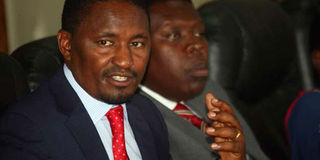Govt to release funds for distribution of water as drought bites

Devolution Cabinet Secretary Mwangi Kiunjuri (left) and Water Cabinet Secretary Eugene Wamalwa address journalists at Treasury House in Nairobi, on January 12, 2017, about the drought situation. Mr Kiunjuri said millions of Kenyans are facing starvation. PHOTO | EVANS HABIL | NATION MEDIA GROUP
What you need to know:
- The government is planning to reduce relief food distribution by 50 per cent in favour of cash transfers.
- Mr Bett said 46,800 range cubes, 22,100 bales of hay, 1,200 litres of molasses and 103,700 kg of urea blocks had been procured and were being distributed.
Water Cabinet Secretary Eugene Wamalwa has said Sh1.6 billion would be released before the end of this month to boost water supply between January and March, as the drought situation escalates.
Mr Wamalwa said the water will be used to benefit both humans and livestock.
“The amount will cater for up-scaling of water trucking and storage for people, livestock and wildlife, distribution of water bowsers, repair and rehabilitation of boreholes and fuel subsidy for the boreholes,” he said and called for prudent use of the commodity, saying the water levels at the Ndakaini Dam were at only 41 per cent.
At a press conference, Treasury Cabinet Secretary Henry Rotich, accompanied by Mr Wamalwa, Mr Willy Bett (Agriculture) and Mr Mwangi Kiunjuri (Devolution) said the government is seeking to raise beyond the Sh9.5 billion it had set aside to mitigate the effects of the worsening drought.
“We are relying on meteorologists to give us constant projections on the situation and we are ready to restructure the budget,” Mr Rotich said.
Currently, 1.5 million people across the country require urgent assistance.
Mr Rotich said a total of Sh286 million had been used in cash transfer programmes and that the number of households receiving the Sh2,700 per month in Wajir, Turkana, Mandera and Marsabit had increased.
The government is planning to reduce relief food distribution by 50 per cent in favour of cash transfers and increase the number of homes receiving the kitty by 34,000 in nine more counties, he said.
Mr Bett said there were 21 million bags of maize in the food reserves by the end of last year and that it could last the country until early June this year.
The stocks are for both human consumption and livestock feeds production.
“The plan is to maintain rice and wheat imports under the current arrangements so rice importers and grain millers can fill the deficit created by other commodities,” he said, adding that the government had formed a multi-agency team consisting of non-government agencies, the UN and the private sector to assess the food security situation.
“From their report that will be ready by the end of this month, we will be able to know the severity of the drought in terms of the most vulnerable areas, populations and resources required,” he said.
FOOD IMPORTS
From the report, the government would decide whether or not there was need to allow the importation of maize to beef up the food stocks.
Mr Bett said 46,800 range cubes, 22,100 bales of hay, 1,200 litres of molasses and 103,700 kg of urea blocks had been procured and were being distributed to mitigate acute livestock feed shortage in arid and semi-arid counties.
He urged Kenyans living in those areas to sell livestock whose health had deteriorated to the government under the livestock take-off plan.
“So far, 4,758 head of cattle have been procured under the plan and we encourage pastoralists to sell their cattle when they can still fetch fair prices,” he said.
The livestock would then be slaughtered and distributed to schools, institutions and vulnerable households to enhance nutrition.
The CS said the government had procured 1.5 million dozes of livestock vaccines for distribution to pastoralists.
The ministers were speaking at a joint press briefing at Kilimo House, where they asked all agencies to enhance their drought response actions.





